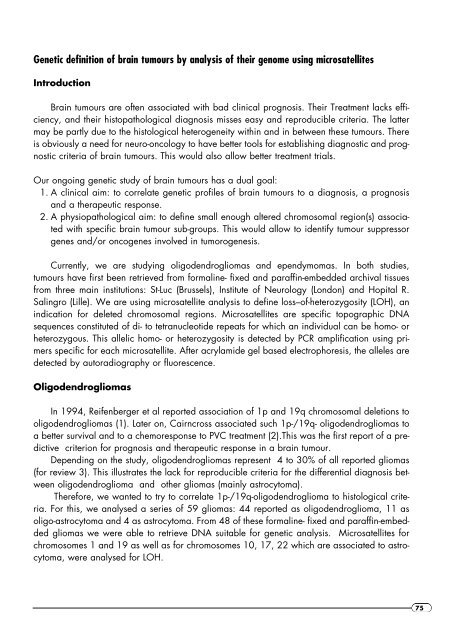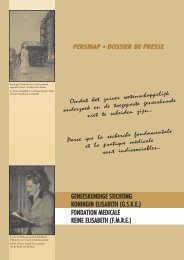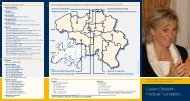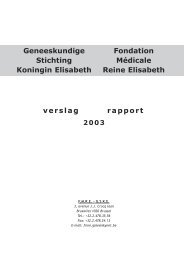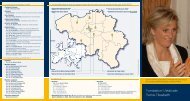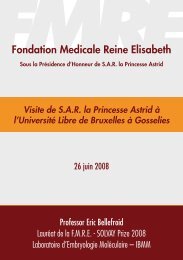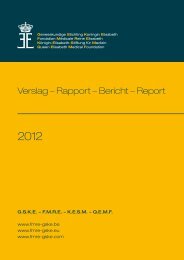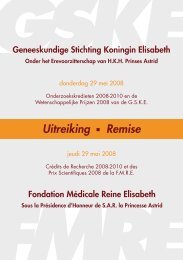Geneeskundige Stichting Koningin Elisabeth ... - GSKE - FMRE
Geneeskundige Stichting Koningin Elisabeth ... - GSKE - FMRE
Geneeskundige Stichting Koningin Elisabeth ... - GSKE - FMRE
You also want an ePaper? Increase the reach of your titles
YUMPU automatically turns print PDFs into web optimized ePapers that Google loves.
Genetic definition of brain tumours by analysis of their genome using microsatellites<br />
Introduction<br />
Brain tumours are often associated with bad clinical prognosis. Their Treatment lacks efficiency,<br />
and their histopathological diagnosis misses easy and reproducible criteria. The latter<br />
may be partly due to the histological heterogeneity within and in between these tumours. There<br />
is obviously a need for neuro-oncology to have better tools for establishing diagnostic and prognostic<br />
criteria of brain tumours. This would also allow better treatment trials.<br />
Our ongoing genetic study of brain tumours has a dual goal:<br />
1. A clinical aim: to correlate genetic profiles of brain tumours to a diagnosis, a prognosis<br />
and a therapeutic response.<br />
2. A physiopathological aim: to define small enough altered chromosomal region(s) associated<br />
with specific brain tumour sub-groups. This would allow to identify tumour suppressor<br />
genes and/or oncogenes involved in tumorogenesis.<br />
Currently, we are studying oligodendrogliomas and ependymomas. In both studies,<br />
tumours have first been retrieved from formaline- fixed and paraffin-embedded archival tissues<br />
from three main institutions: St-Luc (Brussels), Institute of Neurology (London) and Hopital R.<br />
Salingro (Lille). We are using microsatellite analysis to define loss–of-heterozygosity (LOH), an<br />
indication for deleted chromosomal regions. Microsatellites are specific topographic DNA<br />
sequences constituted of di- to tetranucleotide repeats for which an individual can be homo- or<br />
heterozygous. This allelic homo- or heterozygosity is detected by PCR amplification using primers<br />
specific for each microsatellite. After acrylamide gel based electrophoresis, the alleles are<br />
detected by autoradiography or fluorescence.<br />
Oligodendrogliomas<br />
In 1994, Reifenberger et al reported association of 1p and 19q chromosomal deletions to<br />
oligodendrogliomas (1). Later on, Cairncross associated such 1p-/19q- oligodendrogliomas to<br />
a better survival and to a chemoresponse to PVC treatment (2).This was the first report of a predictive<br />
criterion for prognosis and therapeutic response in a brain tumour.<br />
Depending on the study, oligodendrogliomas represent 4 to 30% of all reported gliomas<br />
(for review 3). This illustrates the lack for reproducible criteria for the differential diagnosis between<br />
oligodendroglioma and other gliomas (mainly astrocytoma).<br />
Therefore, we wanted to try to correlate 1p-/19q-oligodendroglioma to histological criteria.<br />
For this, we analysed a series of 59 gliomas: 44 reported as oligodendroglioma, 11 as<br />
oligo-astrocytoma and 4 as astrocytoma. From 48 of these formaline- fixed and paraffin-embedded<br />
gliomas we were able to retrieve DNA suitable for genetic analysis. Microsatellites for<br />
chromosomes 1 and 19 as well as for chromosomes 10, 17, 22 which are associated to astrocytoma,<br />
were analysed for LOH.<br />
75


